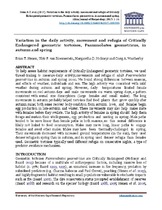| dc.contributor.author | Henen, Brian T. | |
| dc.contributor.author | van Bloemestein, Ulric P. | |
| dc.contributor.author | Hofmeyr, Margaretha D. | |
| dc.contributor.author | Weatherby, Craig A. | |
| dc.date.accessioned | 2017-12-07T10:08:26Z | |
| dc.date.available | 2017-12-07T10:08:26Z | |
| dc.date.issued | 2017 | |
| dc.identifier.citation | Hene, B.T. et al. (2017). Variation in the daily activity, movement and refugia of Critically Endangered geometric tortoises, Psammobates geometricus, in autumn and spring. Africa Journal of Herpatology, 2017: 1-14. | en_US |
| dc.identifier.issn | 2156-4574 | |
| dc.identifier.uri | http://dx.doi.org/10.1080/21564574.2017.1331935 | |
| dc.identifier.uri | http://hdl.handle.net/10566/3306 | |
| dc.description.abstract | To help assess habitat requirements of Critically Endangered geometric tortoises, we used thread-trailing to measure daily activity, movements and refugia of adult Psammobates geometricus in autumn and spring 2002. We found strong differences between seasons, and effects of weather, individuals and sex. The high activity was consistent with mild weather during autumn and spring. However, daily temperatures limited female movements on cool autumn days and male movements on warm spring days, a pattern consistent with sexual size dimorphism (large females and small males). The long movements in autumn probably helped tortoises find food plants that grow quickly after autumn rains; both sexes recover body condition from autumn lows, and females begin egg production in late-autumn and winter. These movements may also help males mate with females before they ovulate. The high activity of females in spring should help them forage and sustain their vitellogenesis, egg production and nesting in spring. Male paths tended to be more linear than female paths in both seasons, so this sexual difference is likely not linked to food consumption. Males may move long, linear paths to engage females and avoid other males. Males may have been thermally-challenged in spring. Their movements decreased with increased ground temperatures (in the sun), they used denser refugia in spring than in autumn, and in spring used denser refugia than females used. Geometric tortoises typically used different refugia on consecutive nights, a type of predator avoidance mechanism. | en_US |
| dc.language.iso | en | en_US |
| dc.publisher | Taylor & Francis | en_US |
| dc.subject | Fynbos biome | en_US |
| dc.subject | Habitat requirements | en_US |
| dc.subject | Predator avoidance | en_US |
| dc.subject | Season | en_US |
| dc.subject | Sex | en_US |
| dc.subject | Thermoregulation | en_US |
| dc.subject | Thread-trailing | en_US |
| dc.title | Variation in the daily activity, movement and refugia of Critically Endangered geometric tortoises, Psammobates geometricus, in autumn and spring | en_US |
| dc.type | Article | en_US |
| dc.privacy.showsubmitter | FALSE | |
| dc.status.ispeerreviewed | TRUE | |

